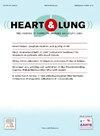急性失代偿性心力衰竭患者的 "门到利尿剂时间 "与住院时间长短有关,与利尿剂剂量无关。
IF 2.4
4区 医学
Q2 CARDIAC & CARDIOVASCULAR SYSTEMS
引用次数: 0
摘要
背景:急性失代偿性心力衰竭(ADHF)治疗指南推荐了利尿剂的初始剂量,但缺乏对治疗时机的指导。最近的证据表明,加快治疗速度或缩短 "门到利尿剂(D2D)时间"(Door-to-Diuretic,D2D)可改善预后:本研究评估了利尿剂剂量、D2D 时间及其相互作用对住院时间的影响:方法:我们分析了一家大型学术中心急诊科 ADHF 患者的病历数据。我们根据利尿剂剂量、D2D 时间及其交互作用计算了住院时间延长(>7 天)的几率,并对年龄、性别、种族、NYHA 分级、肌酐水平、收缩压和合并症负担进行了调整:198名患者共住院275次(平均住院次数:1.48±0.99),其中男性占57%,年龄较大(71岁,IQR:18.5岁),超重/肥胖(30.12,IQR:11.66 kg/m2),有多种并发症(5.6±2.1),射血分数降低(58%,n = 159)。住院时间中位数为 7.0 天(8.0 天)。在住院时间较长的 ADHF 患者中,外周水肿的比例明显更高(28.69% 对 15.68%,P = 0.01)。在未进行协变量调整(OR=1.011609,p = 0.041)和协变量调整(OR=1.012409,p = 0.034)的情况下,D2D 时间对住院时间延长的预测均具有统计学意义。无论是利尿剂剂量还是D2D时间与剂量之间的交互作用都不是重要的预测因素:结论:D2D时间可明显预测住院时间的延长,而不受利尿剂剂量的影响。进一步的研究对完善这些建议至关重要。本文章由计算机程序翻译,如有差异,请以英文原文为准。
Door-to-Diuretic Time is related to length of hospital stay independent of diuretic dose among acute decompensated heart failure patients
Background
Acute decompensated heart failure (ADHF) treatment guidelines recommend initial dosages for diuretic drugs but lack guidance on treatment timing. Recent evidence indicates that faster treatment, or shorter Door-to-Diuretic (D2D) Time, may improve outcomes.
Objectives
This study assessed how diuretic dose, D2D Time, and their interaction affect hospital length of stay.
Methods
Data were analyzed from medical records of ADHF patients in the emergency department of a large academic center. We calculated the odds of longer hospitalization (>7 days) based on diuretic dose, D2D Time, and their interaction, adjusting for age, sex, race, NYHA class, creatinine levels, systolic blood pressure, and comorbidity burden.
Results
Our sample of 198 patients who were hospitalized a total of 275 times (mean: 1.48±0.99 hospitalizations) were predominantly male (57 %), older (71, IQR:18.5), years), overweight/obese (30.12, IQR: 11.66 kg/m2), had multiple comorbidities (5.6 ± 2.1), and had a reduced ejection fraction (58 %, n = 159). The median length of hospital stay was 7.0 days (8.0). Peripheral edema was significantly higher among ADHF patients with prolonged hospitalization (28.69% vs. 15.68 %, p = 0.01). D2D Time was a statistically significant predictor of prolonged hospitalization without (OR=1.011609, p = 0.041) and with (OR=1.012409, p = 0.034) covariate adjustment. Neither the diuretic dose nor the interaction between the D2D Time and dose were significant predictors.
Conclusion
D2D Time significantly predicts prolonged hospitalization independently of diuretic dosing, highlighting a need for revised ADHF guidelines that include both diuretic dosing and timely administration. Further research is essential to refine these recommendations.
求助全文
通过发布文献求助,成功后即可免费获取论文全文。
去求助
来源期刊

Heart & Lung
医学-呼吸系统
CiteScore
4.60
自引率
3.60%
发文量
184
审稿时长
35 days
期刊介绍:
Heart & Lung: The Journal of Cardiopulmonary and Acute Care, the official publication of The American Association of Heart Failure Nurses, presents original, peer-reviewed articles on techniques, advances, investigations, and observations related to the care of patients with acute and critical illness and patients with chronic cardiac or pulmonary disorders.
The Journal''s acute care articles focus on the care of hospitalized patients, including those in the critical and acute care settings. Because most patients who are hospitalized in acute and critical care settings have chronic conditions, we are also interested in the chronically critically ill, the care of patients with chronic cardiopulmonary disorders, their rehabilitation, and disease prevention. The Journal''s heart failure articles focus on all aspects of the care of patients with this condition. Manuscripts that are relevant to populations across the human lifespan are welcome.
 求助内容:
求助内容: 应助结果提醒方式:
应助结果提醒方式:


